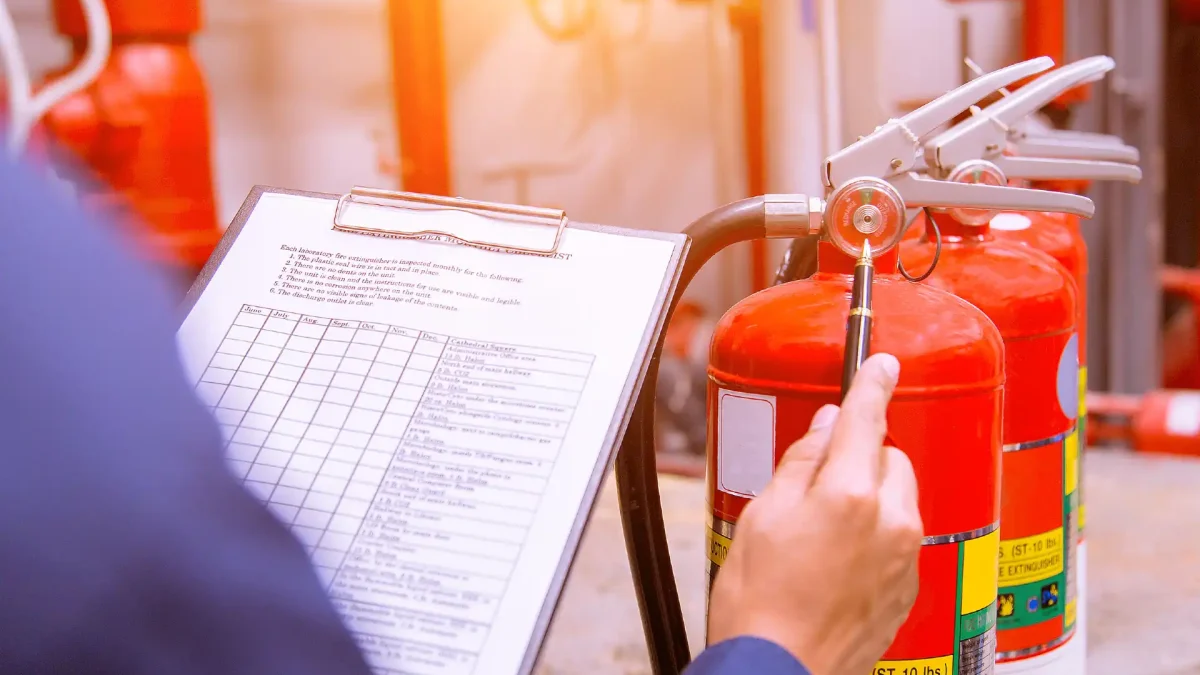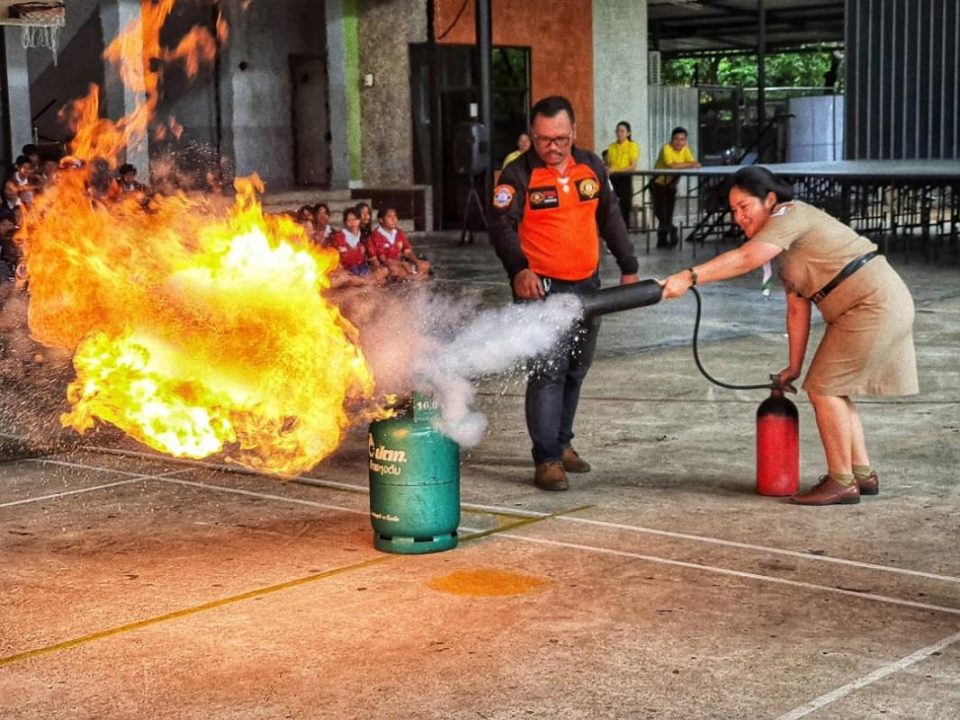Keeping the Sparks at Bay: How Fire Safety Audits Are Revolutionizing Safety Standards in the Electric Vehicle Manufacturing Sector

Fire Safety Audits: A Crucial Aspect of Risk Management for Indian Industrial Facilities
October 2, 2024
Effective Implementation of HAZOP Study: Empowering Process Industry Professionals to Proactively Address Hazards
October 4, 2024In this article, we delve into the critical issue plaguing the electric vehicle manufacturing sector: fire safety. With the rapid rise of electric vehicles on our roads, ensuring the utmost safety standards has become paramount. Enter fire safety audits – a revolutionary approach that is transforming the way we approach safety in EV manufacturing. Join us as we explore the intricacies of these audits, their impact on mitigating fire risks, and how they are reshaping the industry’s safety standards. Be prepared to gain valuable insights, practical tips, and a promise of a safer and more secure future. Let’s dive in!
Introduction
Electric vehicles (EVs) have gained significant popularity in recent years, with their environmental benefits and innovative technology capturing the imagination of consumers worldwide. However, amidst this surge in demand for EVs, there is a crucial aspect that requires our attention: fire safety. The rise of electric vehicles has brought new challenges in ensuring the safety of manufacturing processes and preventing potential fire hazards. In this article, we will delve into the world of fire safety audits and explore how they are revolutionizing safety standards in the electric vehicle manufacturing sector. We will examine the risks associated with EV manufacturing, discuss the evolution of fire safety audits, and highlight their crucial role in detecting potential hazards. By presenting a comprehensive overview of this topic, we aim to equip readers with valuable insights on how fire safety audits are enhancing safety practices across the industry
The importance of fire safety in the electric vehicle manufacturing sector
The electric vehicle manufacturing sector has witnessed a remarkable surge in recent years, spearheading the global shift towards sustainable transportation. However, beneath this eco-friendly facade lies an undeniable truth – the potential risk of fire incidents. The importance of fire safety in this sector cannot be emphasized enough, as it serves as the vital foundation for protecting lives, assets, and the environment. When we consider the unique characteristics of electric vehicles – high-voltage batteries, complex electrical systems, and volatile energy storage mechanisms – it becomes apparent that fire safety is paramount. A single spark or malfunctioning component can quickly escalate into a catastrophic event if not addressed diligently. Therefore, investing in robust fire safety measures is not just a legal obligation but also a moral responsibility for manufacturers in this industry.
Understanding and mitigating the risks associated with electric vehicle manufacturing requires a comprehensive approach that spans from research and design to production and maintenance stages. Fire safety measures must be ingrained at every step of the process to ensure that potential hazards are identified early on and preventative measures are implemented effectively. By prioritizing fire safety audits, manufacturers can proactively address any weak links within their operations and set new industry standards that prioritize both efficiency and safety.
Remember: in an ever-evolving industry like electric vehicle manufacturing, keeping the sparks at bay is not just about mere compliance – it’s about fostering innovation while safeguarding our future on wheels.
Understanding the risks associated with electric vehicle manufacturing
The electric vehicle manufacturing sector presents a unique set of risks that need to be carefully understood and managed. One of the primary risks associated with this industry is the high voltage systems used in electric vehicles. These systems can pose a significant fire hazard if not properly designed, installed, and maintained. Moreover, the lithium-ion batteries used in electric vehicles have been known to cause thermal runaway events, which can lead to fires and explosions if not handled correctly. Another risk factor in electric vehicle manufacturing is the presence of flammable materials such as solvents, adhesives, and lubricants. These substances are commonly used throughout the production process and can increase the potential for fires if not stored or handled properly. Additionally, the use of high-powered charging systems for electric vehicles also brings about potential risks related to electrical faults or malfunctions.
Understanding these risks is crucial because it allows manufacturers to proactively implement safety measures in their facilities. By conducting thorough fire safety audits, companies can identify potential hazards and take appropriate steps to mitigate them. This ensures that employees working in the industry are protected from harm while also safeguarding expensive equipment and preventing devastating accidents.
By addressing these risks head-on through comprehensive fire safety audits, the electric vehicle manufacturing sector demonstrates its commitment to prioritizing safety above all else. Through continuous improvement efforts fuelled by audit findings, manufacturers can create a safer working environment for their employees while fostering public confidence in this rapidly growing industry.
Evolution of fire safety audits in the electric vehicle manufacturing sector
Evolution of fire safety audits in the electric vehicle manufacturing sector: From humble beginnings to a crucial industry practice, the evolution of fire safety audits in the electric vehicle manufacturing sector has been truly remarkable. Initially, safety inspections focused primarily on traditional combustion engine vehicles. However, as electric vehicles gained popularity and production soared, it became evident that a specialized approach was necessary to mitigate potential fire risks.
As technology advanced and electric vehicles became more prevalent, so did the need for comprehensive fire safety audits. These audits underwent a metamorphosis, adapting to the unique challenges posed by high-voltage batteries, intricate electrical systems, and advanced charging infrastructure. Fire safety experts from diverse fields collaborated to develop protocols specifically tailored to the electric vehicle manufacturing sector.
The evolution of fire safety audits also brought about innovative techniques such as thermal imaging cameras capable of detecting abnormal heat patterns in battery packs or electrical components. Additionally, sophisticated software systems were developed to analyse data collected during inspections and identify potential hazards with greater precision. This continuous refinement in auditing methods not only ensures compliance with rigorous safety standards but also paves the way for safer and more reliable electric vehicles.
By embracing these advancements and investing in cutting-edge technology for fire safety audits, manufacturers have demonstrated their commitment to prioritizing consumer safety. This evolution has not only revolutionized industry standards but also instilled confidence among consumers regarding the reliability and security of electric vehicles. As we continue down this path of progress, we can look forward to even safer journeys powered by sustainable transportation solutions.
The role of fire safety audits in detecting potential hazards
In the realm of electric vehicle manufacturing, fire safety audits serve as vigilant guardians, tirelessly scanning the manufacturing environment to detect potential hazards lurking in the shadows. Like skilled detectives, these audits meticulously scrutinize every aspect of the production process, from electrical systems and wiring to battery storage and charging facilities. They leave no stone unturned, ensuring that any potential sources of ignition or fire risks are identified and swiftly addressed. These audits employ a multi-faceted approach to hazard detection, utilizing sophisticated technologies such as thermal imaging cameras to identify abnormal temperature variations in critical areas. Additionally, they meticulously inspect equipment maintenance records and conduct thorough interviews with employees to gain valuable insights into potential fire hazards that may have eluded detection by traditional means.
By placing a strong emphasis on prevention rather than reaction, fire safety audits not only enhance workplace safety but also foster a culture of vigilance. Their proactive nature enables manufacturers to stay one step ahead of potential risks, allowing them to implement targeted preventive measures promptly. This comprehensive approach ensures that electric vehicle manufacturers can continue their mission of building sustainable transportation solutions with unwavering confidence in their safety standards.
Ensuring compliance with safety regulations through fire safety audits
Ensuring compliance with safety regulations through fire safety audits plays a pivotal role in the electric vehicle manufacturing sector. These audits serve as a vital tool to assess whether the industry meets stringent safety standards, guaranteeing the well-being of both employees and consumers. By conducting thorough and regular fire safety audits, manufacturers can identify potential hazards, evaluate their existing safety measures, and make necessary improvements. These audits involve detailed inspections of manufacturing facilities, equipment, storage areas, and employee training programs. Expert auditors meticulously examine fire prevention systems, such as alarms, sprinklers, and emergency response protocols. By scrutinizing these aspects, companies can ensure that they are in full compliance with local regulations and industry guidelines.
Moreover, fire safety audits provide an opportunity for companies to showcase their commitment to maintaining a safe working environment. Through regular internal assessments or third-party audits by independent experts in fire safety engineering, manufacturers can demonstrate their dedication to protecting employees and exceeding regulatory requirements. By continuously striving for excellence in fire safety standards through these audits, electric vehicle manufacturers contribute not only to their own success but also to building trust among consumers who prioritize safety when choosing electric vehicles.
Implementing preventive measures based on audit findings
Implementing preventive measures based on audit findings: After conducting a comprehensive fire safety audit, it is crucial for electric vehicle manufacturers to take prompt action in implementing preventive measures based on the findings. These measures serve as a shield against potential fire hazards, ensuring the safety of both employees and valuable assets within the manufacturing facility.
One effective approach involves establishing robust fire suppression systems strategically placed throughout the manufacturing facility. These systems, equipped with state-of-the-art technology, can swiftly detect any signs of fire and activate automatic suppression mechanisms. By incorporating advanced sensors and extinguishing agents specifically designed for electric vehicle fires, manufacturers can confidently mitigate risks and minimize potential damages.
Additionally, proactive maintenance of electrical infrastructure is paramount. Regular inspections and testing of electrical components can identify potential faults or overheating issues that could lead to fires. Prompt repairs or replacements can eliminate such risks before they escalate into hazardous situations. Adhering to stringent maintenance schedules not only ensures compliance with safety standards but also fosters a culture of vigilance in maintaining a fire-safe environment.
Lastly, comprehensive employee training programs are vital for creating a workforce that is well-informed about fire safety protocols. Regular drills and simulations provide employees with practical knowledge on how to respond swiftly and effectively during emergencies. Encouraging a sense of responsibility among all staff members cultivates a collective commitment towards preventing fires and enhances overall safety awareness within the manufacturing facility.
By diligently implementing these preventive measures derived from audit findings, electric vehicle manufacturers can significantly reduce the likelihood of fires occurring during production processes. This concerted effort reinforces their dedication towards fostering an environment that prioritizes employee well-being while simultaneously ensuring optimal protection for valuable assets – allowing them to continue revolutionizing the sector with confidence and peace of mind.
Training and educating employees on fire safety protocols
As the sparks of innovation continue to ignite the electric vehicle manufacturing sector, it becomes imperative to train and educate employees on fire safety protocols. Emphasizing the importance of fire safety not only ensures a secure work environment but also instils a sense of responsibility amongst the workforce. Through comprehensive training programs, employees gain valuable knowledge about potential hazards, firefighting techniques, and emergency response procedures. During these training sessions, employees are immersed in interactive simulations that replicate real-life scenarios. They learn how to identify potential ignition sources, handle flammable materials safely, and operate fire extinguishers effectively. Furthermore, they are educated on evacuation plans and the importance of clear communication during emergencies. By equipping employees with this vital information, companies can foster a culture of safety where everyone actively contributes to mitigating fire risks.
In addition to formal training programs, ongoing education is crucial in ensuring continuous improvement in fire safety practices. Regular workshops and refresher courses serve as timely reminders for employees regarding updated protocols and new technologies. By staying up-to-date with advancements in fire safety measures, employees can adapt swiftly to changing circumstances and contribute proactively towards maintaining a safe workplace environment. This commitment to continuous learning creates a positive atmosphere where everyone feels empowered and confident in their ability to prevent fires effectively.
Through training and education initiatives focused on fire safety protocols, electric vehicle manufacturers are nurturing a workforce that is well-informed about potential risks and equipped with the necessary skills to respond swiftly during emergencies. By investing in employee development programs that prioritize fire safety awareness and knowledge enhancement, companies demonstrate their unwavering dedication towards safeguarding their most valuable asset – their people
Integrating advanced technologies in fire safety audits
Embracing cutting-edge technological advancements has become imperative in revolutionizing fire safety audits within the electric vehicle manufacturing sector. One such innovation is the utilization of infrared thermography cameras, which enable auditors to identify potential hotspots or malfunctions in electrical systems with unprecedented accuracy. These cameras can detect temperature variations, allowing early detection and prevention of fire hazards. By harnessing the power of artificial intelligence, these tools can also provide real-time analysis and generate detailed reports for further assessment. Moreover, the integration of smoke and gas detection systems equipped with advanced sensors has significantly enhanced fire safety audits. These systems employ highly sensitive detectors capable of identifying even minute traces of toxic fumes or smoke particles that might indicate potential fire outbreaks. Additionally, incorporating state-of-the-art monitoring systems equipped with wireless connectivity ensures prompt communication between the audit team and emergency response units, facilitating swift action in critical situations.
By seamlessly integrating these advanced technologies into fire safety audits, electric vehicle manufacturers are not only mitigating risks but also fostering a culture of proactive prevention. This positive approach instils confidence among stakeholders by assuring them that every measure is being taken to ensure utmost safety. As technology continues to evolve, so does our ability to safeguard against potential hazards, paving the way for a safer and brighter future for the electric vehicle industry as a whole.
Collaborating with fire safety experts for comprehensive audits
Collaborating with fire safety experts for comprehensive audits: In the pursuit of achieving top-tier fire safety standards, electric vehicle manufacturers recognize the invaluable expertise that fire safety experts bring to the table. Collaborating with these professionals ensures comprehensive audits that leave no stone unturned in identifying potential risks. These experts possess an intricate knowledge of fire dynamics and cutting-edge technology, allowing them to provide a fresh perspective and identify hidden vulnerabilities within manufacturing facilities.
Fire safety experts work hand in hand with manufacturers to conduct meticulous audits that encompass all aspects of fire prevention and control. They meticulously inspect electrical systems, machinery, storage areas, and production lines to assess compliance with safety regulations. By leveraging their expertise, these professionals offer invaluable insights into best practices and emerging technologies that can further enhance fire safety measures.
Through collaboration with fire safety experts, electric vehicle manufacturers not only gain access to their profound knowledge but also benefit from their proactive approach to risk assessment. These industry specialists not only identify hazards but also provide tailored recommendations for mitigating risks effectively. This collaborative effort establishes a culture of continuous improvement where manufacturers actively engage with these experts to embrace innovative strategies and stay at the forefront of fire safety advancements.
By working together with experienced professionals, electric vehicle manufacturers can rest assured knowing that they have done everything possible to ensure the utmost protection against potential fires. Emphasizing this cooperation in comprehensive audits instils confidence in both employees and stakeholders alike by demonstrating a commitment to safeguarding lives, property, and reputation within the industry.
Tracking and analysing audit results for continuous improvement
Tracking and analysing audit results for continuous improvement: The diligent tracking and analysis of fire safety audit results in the electric vehicle manufacturing sector pave the way for remarkable advancements in safety standards. Every audit reveals valuable insights, enabling manufacturers to identify recurring issues, trends, and areas that require immediate attention. By meticulously documenting findings and utilizing sophisticated data analytics tools, manufacturers can gain a comprehensive understanding of their fire safety performance.
This deep analysis not only helps identify specific weaknesses but also enables manufacturers to develop targeted solutions and preventive measures. By implementing these improvements proactively, companies can enhance their overall fire safety protocols, mitigating risks effectively. Such a meticulous approach brings about an optimistic spin as it instils confidence in employees’ minds, fosters a culture of safety awareness, and reassures stakeholders that every effort is being made to ensure the utmost protection against potential fire hazards.
Furthermore, through continuous monitoring and analysis of audit results over time, patterns emerge. These patterns provide valuable insights into long-term trends and identify areas where consistent improvement has been achieved. This data-driven approach empowers manufacturers to make informed decisions regarding investments in infrastructure upgrades or technology advancements while fostering an environment of innovation that drives the electric vehicle industry forward.
In conclusion, tracking and analysing audit results is an integral part of maintaining high safety standards in the electric vehicle manufacturing sector. It not only allows for targeted improvements but also promotes a positive culture of continuous enhancement by leveraging data-driven insights. Through this commitment to ongoing evaluation and improvement, manufacturers can ensure that their facilities remain at the forefront of fire safety measures in the dynamic world of electric vehicle production
Conclusion
Electric vehicle manufacturing is a rapidly growing industry, and with it comes the need for robust fire safety measures. Fire safety audits have emerged as a revolutionary tool in ensuring the highest standards of safety in this sector. By detecting potential hazards, ensuring compliance with regulations, implementing preventive measures, and integrating advanced technologies, these audits play a crucial role in mitigating fire risks. As electric vehicles continue to gain popularity and become an integral part of our transportation landscape, the relentless pursuit of fire safety will ensure that sparks are kept at bay, paving the way for a brighter and safer future.




